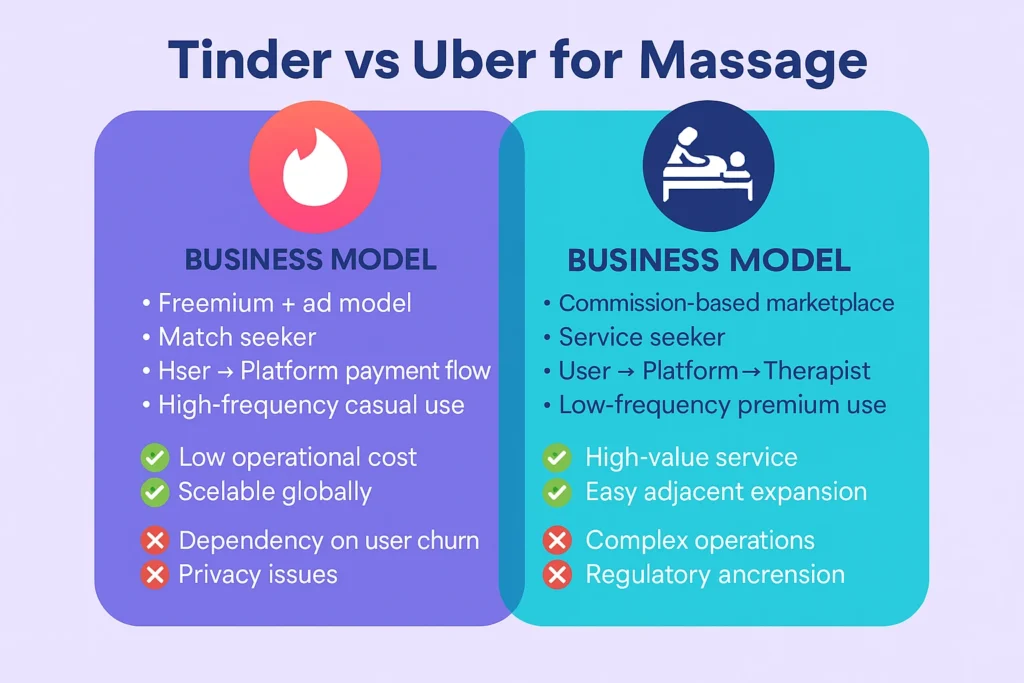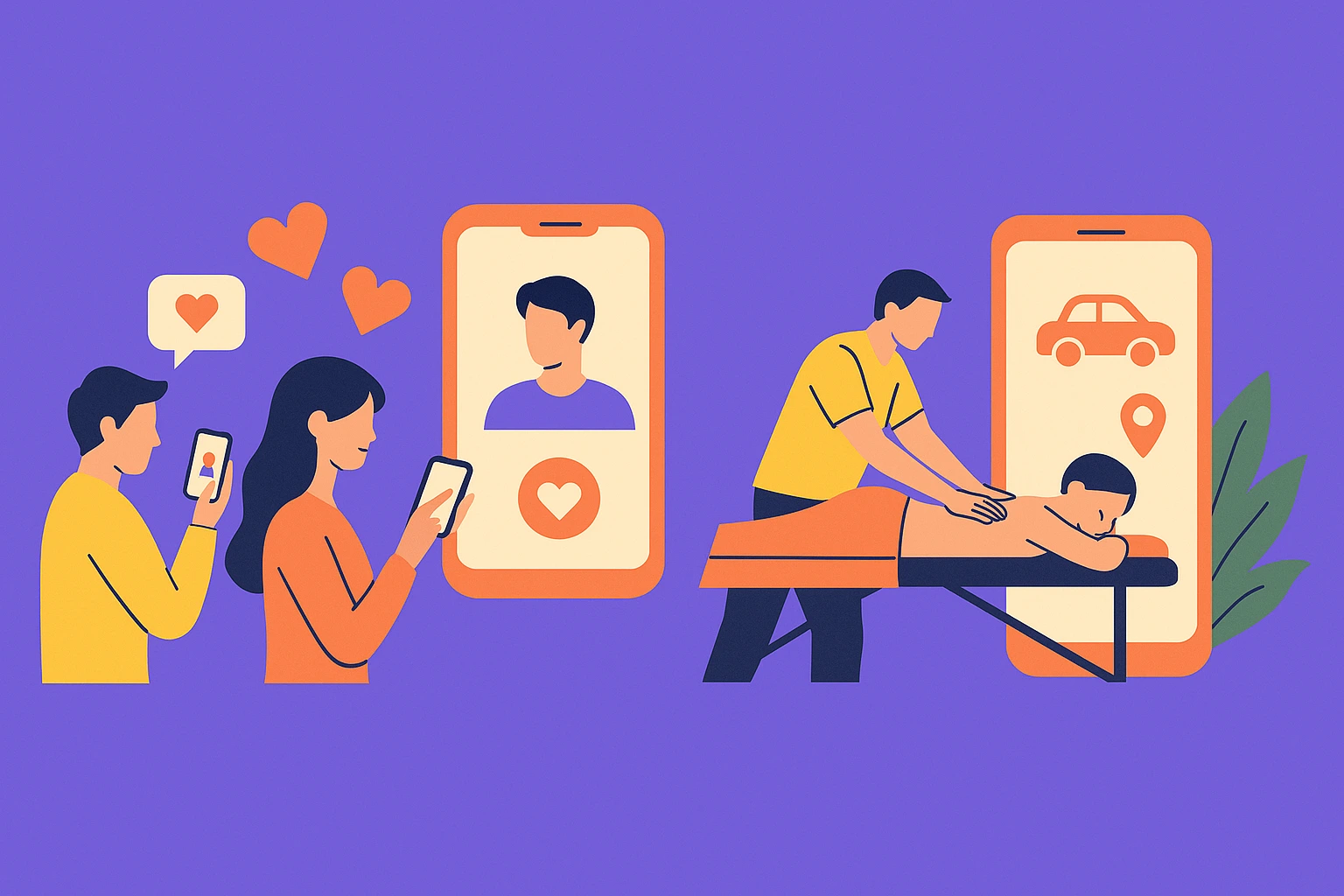In 2025, the boundaries between digital dating, wellness, and on-demand services are increasingly blurring. While Tinder and Uber for Massage operate in completely different sectors—dating vs. wellness—their underlying business models offer intriguing insights for startup founders and app entrepreneurs looking to build marketplace platforms.
Both Tinder and Uber for Massage exemplify platform-centric, location-based, and convenience-first experiences. However, one is built on social matching and freemium monetization, while the other relies on on-demand service fulfillment and commission revenue.
If you’re planning to build the next disruptive app in wellness, lifestyle, or even niche marketplaces, this comparison will help you:
- Understand user psychology and engagement strategies.
- Choose the right revenue model and partner ecosystem.
- Scale your app idea with clear unit economics.
Let’s dive into what makes each model tick in the digital economy of 2025.

What is Tinder?
Tinder is one of the world’s most popular online dating apps, offering a swipe-based interface to help users discover and connect with potential matches nearby. Launched in 2012, it pioneered the gamified dating experience and became a cultural phenomenon.
As a two-sided marketplace, Tinder connects:
- Users seeking relationships (romantic, casual, or otherwise)
- Through location-based matching algorithms and behavioral data
The app does not host or verify real-life interactions but facilitates connections that often lead to them. It thrives on user engagement, subscription upsells, and advertising.
What is Uber for Massage?
Uber for Massage refers to an on-demand massage therapy app model that connects customers with certified massage therapists who provide services at home, offices, or hotel rooms. These platforms, such as Soothe, Urban, or Zeel, follow the Uber-style gig economy model.
Core components include:
- Real-time therapist availability
- Service booking, scheduling, and tracking
- Payment, reviews, and safety features
Unlike Tinder, which is discovery-focused, Uber for Massage is service fulfillment-centric. It solves a real-world logistics problem—bringing wellness services to users instantly.
Business Model of Tinder
1. Revenue Streams
- Freemium Upsells: Tinder Plus, Tinder Gold, Tinder Platinum
- In-app Purchases: Boosts, Super Likes
- Subscription Plans: Recurring revenue from premium tiers
- Advertising: Brand placements and targeted ads
2. Cost Structure
- App Development & Maintenance
- Marketing and User Acquisition
- Data Security & Compliance (GDPR, etc.)
- Payment Processing Fees
- Server & Cloud Infrastructure
3. Key Partners
- Ad Networks (Google, Facebook)
- Payment Gateways
- Cloud Service Providers (AWS, GCP)
- AI/ML Vendors for Match Optimization
4. Growth Strategy
- Gamification features to increase engagement
- Global localization
- AI-based matchmaking
- Expansion into social discovery and video dating
Learn More: Business Model of Tinder : How Tinder Makes Money
Business Model of Uber for Massage
1. Revenue Streams
- Commission on Bookings: 20–30% from therapists per session
- Service Fees from Users: Per-booking fees
- Membership Plans: Monthly massage credits and discounts
- Add-ons: Extra time, aromatherapy, couple packages
2. Cost Structure
- Therapist Onboarding & Background Checks
- Scheduling & Logistics Tech
- Customer Support
- Insurance & Legal Compliance
- Marketing & Promotions
3. Key Partners
- Licensed Massage Therapists
- Wellness Insurance Providers
- Hotel & Corporate Tie-ups
- CRM & Scheduling Platforms
4. Growth Strategy
- Geographic expansion
- Corporate wellness partnerships
- Integrations with smart homes & wearables
- AI therapist routing & optimization
Learn More: Best Uber for Massage Clone Scripts in 2025 – Features & Pricing
Comparison Table: Tinder vs Uber for Massage
| Feature | Tinder | Uber for Massage |
| Category | Online Dating | On-demand Wellness Services |
| Core Model | Freemium + Ad Model | Commission-based Marketplace |
| User Role | Match seeker | Service seeker |
| Provider Role | Not applicable | Licensed massage therapist |
| Payment Flow | User → Platform | User → Platform → Therapist |
| Revenue Source | Subscriptions, Ads, Purchases | Commissions, Fees, Memberships |
| Growth Driver | User engagement & retention | Service reliability & coverage |
| App Usage Type | High-frequency casual use | Low-frequency premium use |
| Global Scope | 190+ countries | Mostly metro-focused |
Pros & Cons of Tinder’s Business Model
Pros
- Low operational cost (no service delivery involved)
- Scalable with minimal infrastructure
- Strong monetization via gamification
- Global user base and community-driven growth
Cons
- High dependency on user churn and novelty
- Limited defensibility (new dating apps pop up frequently)
- Privacy & moderation issues
- Difficult to expand into service fulfillment
Pros & Cons of Uber for Massage Business Model
Pros
- Real-world impact and high-value service
- Strong repeat business from loyal users
- Easy expansion into adjacent wellness verticals
- Better per-user monetization potential
Cons
- Complex operations (vetting, insurance, logistics)
- Regulatory hurdles (licenses, health & hygiene)
- Limited scalability in rural or low-density markets
- Requires large pool of therapists to match demand
Market Data: Growth, Revenue, Funding
| Metric | Tinder | Uber for Massage |
| Annual Revenue (2024 est.) | $2.2 Billion | $120–150 Million (top players) |
| Revenue Model | Subscription + Ads | Commission + Service Fees |
| Global Market Presence | 190+ countries | 20+ metro regions (US, EU) |
| Estimated Market CAGR | 6.4% (Online Dating) | 12.1% (Wellness On-demand) |
| Average Customer LTV | $60–150 | $180–350 |
| Average Order Value (AOV) | Low (in-app purchases) | High (per session $70–150) |
| User Retention Curve | Shallow | Steady if service is high quality |
Which Model is Better for Startups in 2025?
The Tinder model is better for:
- Rapid user acquisition
- Building network effects
- Monetizing engagement
The Uber for Massage model is better for:
- Solving logistics and availability gaps
- High-ticket monetization
- Expansion into the health & wellness economy
If your startup aims to focus on social interactions, engagement, and gamification, Tinder’s approach gives you a lightweight, scalable way to grow.
If you’re solving a real-world wellness or professional services problem, Uber for Massage gives you a mission-critical, need-based model with deeper retention and higher margins.
Choose Tinder-Style If…
- You want to create a dating, friend-finding, or social matching app
- You aim to scale fast with low operational overhead
- Your product revolves around gamification and engagement metrics
Launch Your Own Tinder Clone with Miracuves
Choose Uber for Massage-Style If…
- You’re building an app for massage, home therapy, or wellness delivery
- You want to control logistics and pricing
- Your goal is to create a trusted professional service marketplace
Build Your Own Uber for Massage Clone App with Miracuves
Conclusion
Whether you’re leaning toward the user-centric engagement model of Tinder or the logistics-heavy yet high-value model of Uber for Massage, the real key lies in choosing the right foundation for growth.
At Miracuves, we help you replicate these proven models with our custom clone app solutions. From feature-rich MVPs to enterprise-ready platforms, we support every stage of your app’s evolution.
Let us help you launch smarter, scale faster, and own your market.
FAQs
1. What is the main revenue difference between Tinder and Uber for Massage?
Tinder earns through subscriptions and ads, while Uber for Massage earns via commissions and service fees.
2. Can I build a Tinder-style app for professionals or networking?
Yes! The Tinder model is easily adaptable to niche use cases like professional matching, mentorship, or friend discovery.
3. What are the tech challenges in an Uber for Massage model?
Real-time scheduling, safety checks, therapist onboarding, and logistics optimization are key challenges.
4. Which model has better retention?
Uber for Massage tends to have better retention per paying user, while Tinder depends on constant engagement.
5. Does Miracuves offer white-label app solutions for both models?
Yes. Miracuves offers robust, scalable clone app development for both Tinder-style and Uber for Massage-style platforms.








